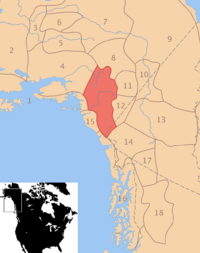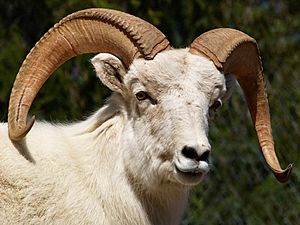Upper Kuskokwim people facts for kids

Nr.5 Upper Kuskokwim homeland
|
|
| Total population | |
|---|---|
| 100 | |
| Regions with significant populations | |
| Languages | |
| Upper Kuskokwim language, American English (Alaskan variant) | |
| Religion | |
| Shamanism (largely ex), Christianity |
The Upper Kuskokwim people are a group of Alaskan Athabaskans who speak an Athabaskan language. They are also known by their native name, Dichinanek' Hwt'ana, which means 'Timber River people'. In the past, they were sometimes called 'Kolchan'.
These people are the original residents of villages like Nikolai, Telida, and McGrath in Alaska. About 25 out of 100 Upper Kuskokwim people still speak their native language. This language is more like the Lower Tanana language than the Deg Xinag language, which is spoken in the middle Kuskokwim area.
The Upper Kuskokwim culture is based on hunting and gathering. They traditionally followed a matrilineal system, meaning family lines are traced through the mother. They were also semi-nomadic, moving between different camps but often returning to the same spots.
Their neighbors are other Athabaskan-speaking groups, including the Koyukon (to the north), Holikachuk (northwest), Deg Xitʼan (southwest), and Denaʼina (southeast).
Contents
Groups and Communities
In the past, the Upper Kuskokwim area had six different groups of people. Over time, these groups came together to form one main community, which is now Nikolai Village.
Here are the traditional Upper Kuskokwim regional groups:
- Telida group — They lived along the McKinley Fork (Swift Fork) and often spent winters in Telida.
- East Fork group — Their winter villages were at Slow Fork and Dennis Creek.
- South Fork group — They had villages in the Farewell area or near the mouth of the Tonzona River. One of these villages later moved and became Nikolai village.
- Salmon River group — They lived along the Salmon River and the Pitka and Middle Fork of the Kuskokwim.
- Big River group — They used Big River and the Middle Fork, with winter villages at Farewell Landing and the mouth of Big River.
- Unnamed group — These people lived around Vinasale Mountain and had strong connections with the former Tatlawiksuk and Takotna River groups.
Here are the main Upper Kuskokwim communities today:
- McGrath was a seasonal village for the Upper Kuskokwim Athabaskans.
- Takotna had a mix of Athabaskan and Yupîk Eskimo people.
- Nikolai is an Upper Kuskokwim Athabaskan village.
- Telida is an Upper Kuskokwim Athabaskan village.
History of the People
The first written records about the Upper Kuskokwim people and their trade came from Lavrenty Zagoskin. He was a Russian naval officer who explored the interior of Russian America in the 1830s.
During the 1830s, the Russians set up trading posts near the Upper Kuskokwim people. These included Kolmakof Redoubt and a small post at Vinasale on the Kuskokwim River. After the U.S. bought Alaska in 1867, Americans took over these trading stations and the fur trade.
Hunting and Gathering Life
The homeland of the Upper Kuskokwim Athabaskans is part of the Denali National Park and Preserve. This area is known as the Tanana-Kuskokwim Lowlands. The Upper Kuskokwim name for Denali mountain is Denaze, which means 'the tall one'.
The Upper Kuskokwim Athabaskans were semi-nomadic hunter-gatherers. They moved around their territory throughout the year to find fish, birds, mammals, and berries. People from Nikolai and Telida hunted in the Alaska Range for many generations, even into the 1900s.
Today, their economy is a mix of traditional subsistence (living off the land) and cash. They mostly use wild resources for their own families. Cash can be hard to come by because there are not many jobs, and people prioritize hunting and gathering.
Hunting Large Animals
The main large animals they hunted were Dall sheep (drodeya), caribou (midzish), black bear (shisr), and grizzly bear (tsone).
Before the late 1800s, moose (dineje) were rare in this area. Caribou were the main animal hunted by native people. Caribou often stayed in the mountains, coming down to the lowlands mostly in winter. Dall sheep were a favorite food, and people would travel to the Alaska Range to hunt them in November. Bears are not hunted as often. A traditional way to hunt bears in winter was to use dogs to find their dens. Small animals like rabbits (gwh) were also hunted.
Hunting Small Game and Birds
Small game, like upland game birds (ptarmigans and grouse), were a good source of fresh meat. Their numbers go up and down, so some years they were hard to find. Spruce grouse (dish), sharp-tailed grouse (ch'iłtwle), ruffed grouse (trok'wda), willow ptarmigan (dilgima), and rock ptarmigan (dziłk'ola) were caught with bows and arrows or snares.
Thousands of waterfowl (ducks and geese) fly through the area in spring. Most move on to nest elsewhere. During the fall migration, many fly over without stopping. Ducks and geese were easy to catch when they were molting (shedding feathers). Men in birchbark canoes would quietly approach the birds and shoot them with bows and arrows. Women and children would then collect the birds and their eggs.
Fishing for Food
Fishing in creeks and rivers was done near villages. Fish were stored in large underground caches. All family members, except very young children, helped with catching and preparing the fish.
Important fish species include chinook salmon, silver salmon, chum salmon, and various whitefish. The main fish (łuk'a) species are Pacific salmon. In the Upper Kuskokwim region, salmon have always been a vital food source. Three types of Pacific salmon reach this area: king or chinook (gas), dog or chum (srughat'aye), and silver or coho (nosdlaghe). While millions of salmon enter the Kuskokwim River, only a few thousand reach the headwaters. In the Upper Kuskokwim language, August is called nosdlagheno'o, meaning 'coho salmon month'.
Other fish like whitefish, northern pike, Arctic grayling, and burbot are also present. Dolly Varden trout (hoch'ilmoya) used to be more common. Round whitefish (hwstin'), lake whitefish or broad whitefish (tilaya), and humpback whitefish (sajila) are common north of the Alaska Range. Northern pike (ch'ighilduda) are caught in summer, fall, and when the water freezes. Arctic grayling (ts'idat'ana) are caught with fishing rods or nets. Sheefish (zidlaghe) are caught mainly in summer. Burbot (ts’onya) were caught with nets. Traditionally, people used spruce fish traps under the ice in winter to catch Alaska blackfish (hozrighe).
Gathering Plants and Berries

From late spring through summer and early fall, both adults and children gathered many plants and berries.
Fruit and berries like blueberries (jija), salmonberries (tujija'), lowbush cranberries (netl'), highbush cranberries (tsaltsa), raspberries (dwhnikotl'), crowberries (dziłnołt'asr), and kinnikinnick berries (dinish) were eaten fresh. They were also preserved for later or used as medicine. Edible roots like Hedysarum alpinum (Indian potato, tsosr) were also gathered.
Family and Social Structure
The Upper Kuskokwim kinship system is based on what is called an Iroquois kinship system. This shows the importance of their matrilineal clan system. In this system, family groups are traced through the mother's side.
The Upper Kuskokwim social system has three main matrilineal groups, or clans:
- St'chelayu (meaning 'fish people')
- Tonay'tlil'tsitnah (meaning 'middle kind' or 'people in the middle')
- Medzisht'hut'anah (meaning 'caribou people')
Culture and Beliefs
Religion
Traditional Beliefs
Historically, the Upper Kuskokwim people and other Alaskan Athabaskans practiced animism and shamanism. Animism is the belief that spirits live in natural objects and phenomena. Shamans were spiritual leaders who could communicate with these spirits.
Christianity
Today, many Upper Kuskokwim people are strongly Russian Orthodox. This faith came from missionaries who arrived in the mid-1800s from the lower Kuskokwim and Yukon rivers. Churches were built in Nikolai and Telida in the early 1900s.
Traditional Foods
The Alaskan Athabaskan Indian ice cream (nemaje) is a dessert. It is made from berries, Indian potatoes, and fish (like whitefish or sheefish). These ingredients are mixed with fat, which is often Crisco now, but traditionally was bear fat. This dessert is different from the Indian ice cream made by First Nations in British Columbia.
Modern Tribal Groups
Tribal Entities
The United States Bureau of Indian Affairs recognizes several Alaska Native tribal entities for the Upper Kuskokwim Athabaskans:
| Tribal entities | Location (native name) |
|---|---|
| McGrath Native Village | McGrath (Tochak') |
| Nikolai Village | Nikolai (Nikolai) |
| Takotna Village | Takotna (Tochotno') |
| Telida Village | Telida (Tilaydi) |
Alaska Native Corporations
Alaska Native Regional Corporations were created in 1971. This happened when the U.S. Congress passed the Alaska Native Claims Settlement Act (ANCSA).
| Native Village Corporation | Community | Alaska Native Reg. Corp. |
|---|---|---|
| Medfra Native Council Inc. | Medfra | Doyon, Limited |
| MTNT Limited | McGrath | Doyon, Limited |
| MTNT Limited | Nikolai | Doyon, Limited |
| MTNT Limited | Takotna | Doyon, Limited |
| MTNT Limited | Telida | Doyon, Limited |
Tanana Chiefs Conference
The Tanana Chiefs Conference is a group of many Central Alaskan Athabaskans tribes. It does not include the Southern Alaskan Athabaskans like the Denaʼina and Ahtna.
- Upper Kuskokwim Subregion members:
- McGrath Traditional Council, McGrath, for Upper Kuskokwim Athabaskans.
- Medfra Traditional Council, Medfra, for Upper Kuskokwim Athabaskans.
- Edzeno Native Council, Nikolai, for Upper Kuskokwim Athabaskans.
- Takotna Traditional Council, Takotna, for Upper Kuskokwim Athabaskans and Central Alaskan Yup'ik people.
- Telida Native Village Council, Telida, for Upper Kuskokwim Athabaskans.



